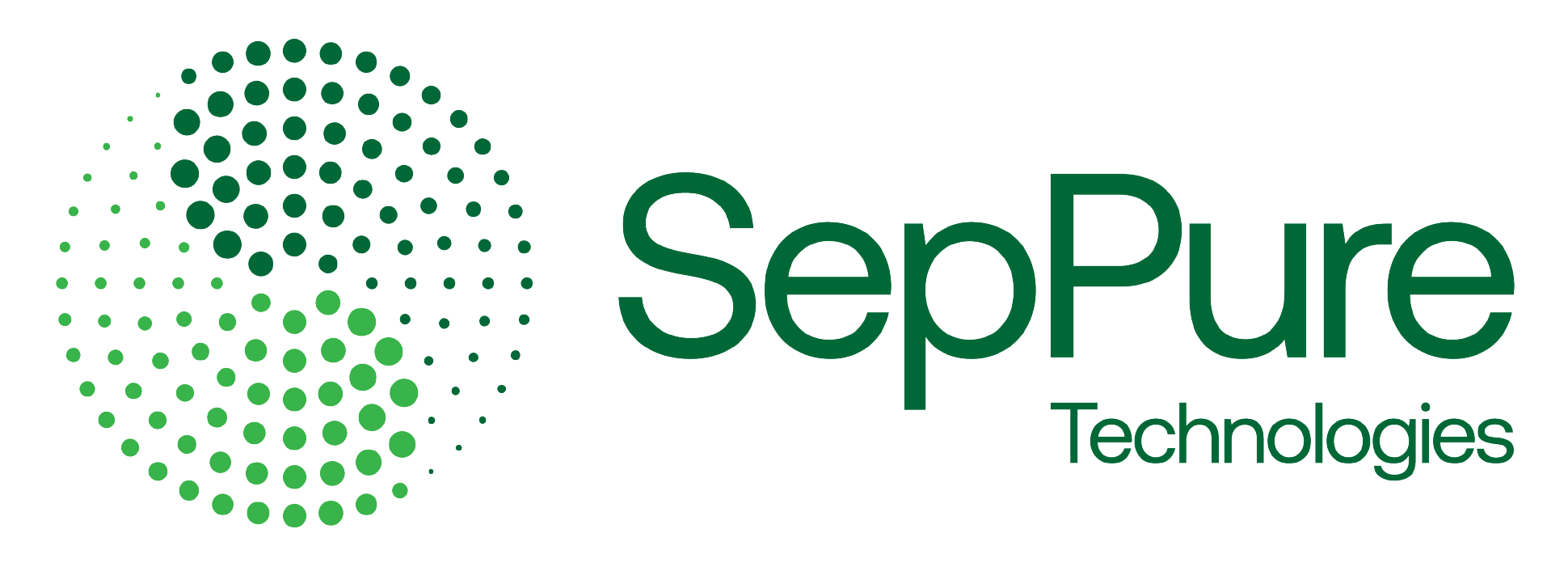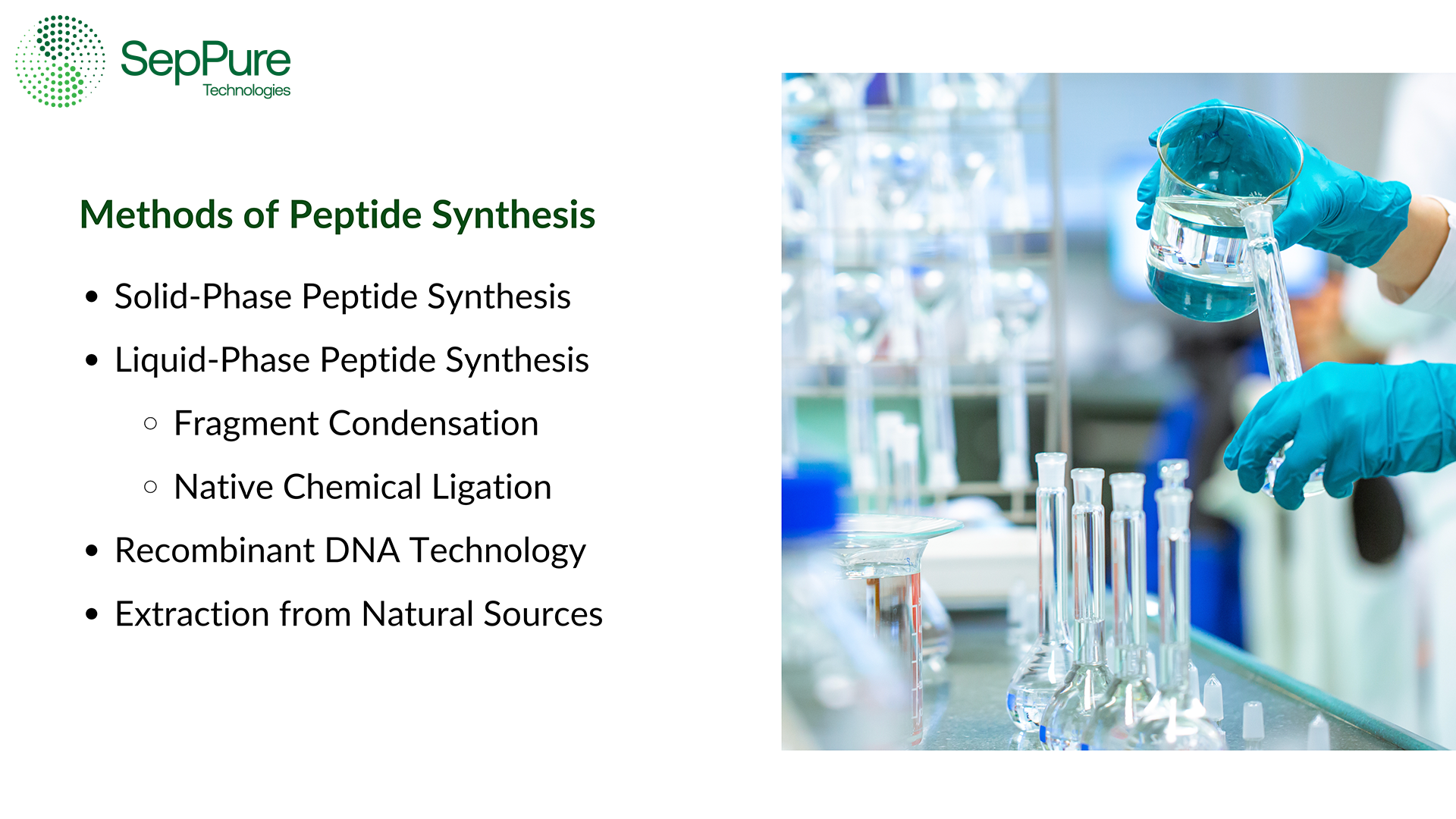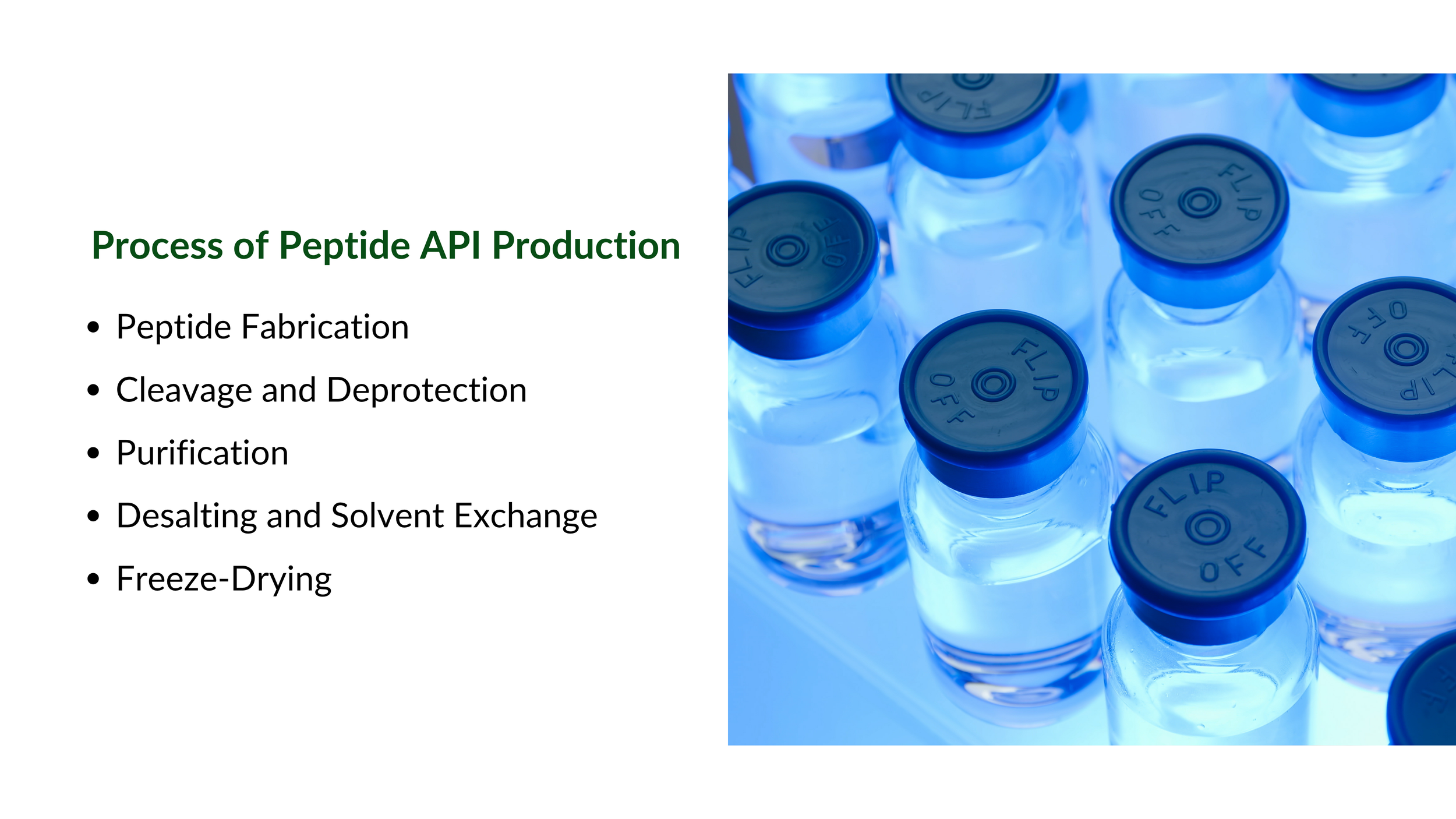OSN Membranes for Greener Peptide Therapeutics
Therapeutic peptides are an emerging and increasingly important class of pharmaceutical agents, composed of short sequences of amino acids, arranged in specific orders. Research into therapeutic peptides began with fundamental studies of natural human hormones, including insulin, oxytocin, vasopressin, and gonadotropin-releasing hormone (GnRH) and their specific physiological activities in the human body. Since the first clinical use of insulin in the early 20th century, therapeutic peptides have evolved significantly. Today, they represent a promising drug modality that bridges the gap between traditional molecules and biologics, offering high specificity and potency with improved pharmacological properties.
Therapeutic peptides offer several compelling advantages that distinguish them from other drug classes, including:
High Specificity and Potency: Peptides exhibit excellent target selectivity due to their ability to mimic natural biological interactions. This reduces off-target effects and enhances therapeutic outcomes.
Favorable Safety Profile: Peptides are generally well tolerated, with lower toxicity and immunogenicity compared to many other biologics and small molecules.
Cost-Effective Manufacturing: Compared to protein therapeutics, peptides are more cost-effective and straightforward to manufacture.
Improved Drug-Like Properties: Advances in formulation and delivery technologies have enabled better oral bioavailability and tissue penetration, historically major challenges for peptide-based drugs.
And more.
These advantages, combined with continued advancements in research and development, have positioned peptides as a versatile and valuable platform for addressing a wide range of applications.
Market Growth and Future Outlook
Therapeutics peptides have emerged as a dynamic and rapidly expanding segment of the global pharmaceutical landscape. Today, nearly 100 peptide-based drugs have received regulatory approval worldwide, with many more transitioning from preclinical development into clinical trials, demonstrating a sustained growth, driven by increasing interest from both academic researchers and industry stakeholders. Between 2016 to 2022 alone, the U.S. Food and Drug Administration (FDA) approved 26 new peptide-based drugs, contributing to a global total of over 80 therapeutic peptides. During this same period, more than 200 peptide candidates entered clinical trials and an additional 600 remained under preclinical investigation, highlighting a robust and expanding development pipeline.
Significant advancements include the approval of semaglutide as the first oral glucagon-like peptide-1 receptor agonist (GLP-1RA) for managing type 2 diabetes mellitus (T2DM) and weight loss. Sales data from 2024 reflects the market dominance of semaglutide formulations, with injectable semaglutide leading global peptide-based drugs sales at USD 13.89 billion. Other semaglutide products followed closely, including injectable dulaglutide at USD 7.13 billion and oral semaglutide at USD 2.72 billion, underscoring the rising demand for peptide-based therapeutics.
Research and innovation in the synthesis of peptide therapeutics continue to accelerate. In November 2023, the introduction of tirzepatide, the first dual glucose-dependent insulinotropic polypeptide (GIP) and GLP-1 receptor agonist, marked a new milestone in weight management and glycemic control. It outperformed single-receptor agonists like dulaglutide and semaglutide in the SURPASS phase III clinical trials. Overall, the growth of the therapeutic peptides market is also mirrored in the commercial domain. In 2022, therapeutic peptides accounted for approximately 5% of the global pharmaceutical market, with an estimated valuation of USD 42.05 billion. Looking ahead, the sector is projected to grow at a robust compound annual growth rate (CAGR) of 10% between 2024 and 2030. This projected expansion will be supported by continued advances in peptide synthesis, engineering, and next-generation delivery platforms.
Methods of Production and Synthesis of Peptides
Peptide synthesis involves creating peptides—short chains of amino acids linked by peptide bonds that play crucial roles in various biological processes. These molecules serve as hormones, enzymes, and signaling agents, making them vital in therapeutic applications. For instance, peptide-based drugs have been developed to treat several conditions, including diabetes, cancer, cardiovascular diseases, and more.
Peptides typically consist of 2 to 50 amino acids, and their specific sequences dictate their three-dimensional structures and biological functions. Advancements in chemical synthesis of peptides have enabled the production of complex peptides with high purity, facilitating the development of novel therapeutics.
Peptides can be synthesized through several methods, including:
Chemical Peptide Synthesis
This method involves building peptides, or short chains of amino acids, by chemically linking them together. This is often done using two main methods: solid-phase peptide synthesis (SPPS) or liquid-phase peptide synthesis. Solid-phase peptide synthesis is the most common technique in research and pharmaceutical development; it anchors the growing peptide chain to an insoluble resin, allowing for repetitive cycles of coupling and deprotection with streamlined purification. Liquid-phase peptide synthesis, while less commonly used today, remains valuable for short sequences and certain large-scale industrial applications. However, despite its versatility, chemical synthesis faces challenges when producing longer or structurally complex peptides, including reduced coupling efficiency, aggregation of growing peptide chains, racemization, and difficulties in purification and solubility, all of which can impact yield, sequence fidelity, and product purity. To overcome these limitations, several strategies have been developed that complement and extend the traditional solid-phase and solution-phase peptide synthesis, including:
Fragment Condensation: This method involves the coupling of pre-assembled peptide segments, reducing synthetic complexity and improving yields for longer sequences.
Native Chemical Ligation (NCL): This is a powerful technique that enables the chemoselective ligation of two unprotected peptide fragments - typically involving a C-terminal thioester and an N-terminal cysteine, resulting in a native peptide bond under aqueous conditions.
Microwave-Assisted SPPS: Accelerates the reaction kinetics and enhances coupling efficiency, particularly in sequences prone to steric hindrance or secondary structure formation. These advancements have broadened the applicability of chemical peptide synthesis, enabling the production of high-purity peptides for diagnostics, therapeutics, and advanced biochemical research.
Other methods of peptide production include:
Recombinant DNA Technology
This approach involves inserting a gene encoding the desired peptide into an expression system, such as bacteria or yeast, which then produces the peptide through natural cellular processes. This biologically based method is efficient for large-scale production of longer or more complex peptides, including therapeutic proteins and hormones.
Extraction from Natural Sources
Peptides can also be isolated from natural sources such as plants, animal tissues, or microbial cultures using extraction and purification techniques like chromatography. While this method can yield biologically active peptides in their native form, it is often limited by low yield, variability, and the complexity of separating peptides from other biomolecules.
The Process of Peptide API Synthesis
The process of synthesizing peptide-based pharmaceutical active ingredients (APIs) involves several key stages, including:
Peptide Fabrication
Peptide chains are assembled through various methods explained above. This allows amino acids to be chemically linked together in specific sequences in order to form the desired peptides.
Cleavage and Deprotection
After chain assembly, the peptide is cleaved from the resin (in SPPS) and deprotected to remove side-chain protecting groups. This process yields a crude peptide mixture containing the desired peptide alongside various impurities, such as truncated sequences and deletion peptides.
Purification
The crude peptide undergoes purification using reversed-phase high-performance liquid chromatography (RP-HPLC). Reversed-phase HPLC is commonly employed, separating peptides based on hydrophobic interactions. This technique effectively removes impurities, resulting in a purified peptide solution.
Desalting and Solvent Exchange
Following purification, the peptide solution may contain residual salts and solvents that are unsuitable for final formulation. Traditional approaches utilize reverse-phase resins to remove salts and exchange solvents, preparing the peptide for lyophilization.
Freeze-Drying (Lyophilization)
The final purified peptide solution undergoes lyophilization to remove water and organic solvents, producing a stable, dry peptide-based API. This process typically takes between 24 and 48 hours to complete, involving freezing the peptide solution, primary drying (sublimation), and secondary drying (desorption) phases.
Each step in this complex workflow is carefully optimized to ensure high purity and yield while aligning with regulatory and quality requirements. However, while advances in technology have significantly improved efficiency across this value chain, the manufacturing of peptide-based APIs remains a scientifically and operationally demanding process.
Key Challenges in Peptide-Based API Manufacturing
Despite the progress in synthesis technologies and downstream processing, peptide API manufacturing continues to present several key challenges that impact efficiency, sustainability, and scalability, including:
Excessive Solvent Waste in API Production
Solvents are the primary source of waste in chemical processes and the largest contributor to process mass intensity (PMI), accounting for the majority of environmental impact associated with drug production. For small molecules, solvents typically contribute between 80 and 90% of the PMI, with even higher percentages observed in the synthesis of peptides and peptide APIs. For instance, the production of glucagon-like peptides that are often used for the treatment of diabetes and obesity, up to 16,000 kg of chemicals could be needed per kg of API manufactured which involves excessive amounts of solvents.
Limited Scalability of Chromatography for Peptide Purification
Chromatographic techniques, while effective, are often difficult to scale. Therefore, they can pose many challenges for large-scale peptide production due to their complexity and time requirements.
Inefficiencies in Removing Impurities
Peptide-based API synthesis often results in impurities such as truncated sequences, deletion sequences, and racemized amino acids, which are challenging to remove and can affect the efficacy and safety of the final product.
Environmental and Regulatory Pressures
The pharmaceutical industry faces increasing pressure to adopt greener practices and reduce environmental footprint, particularly concerning solvent use and waste management.
Greening Therapeutic Peptide Manufacturing with OSN Membranes
The pharmaceutical industry faces growing pressure to align with sustainability goals and improve manufacturing processes. To meet these challenges, several strategies are proposed and are gradually implemented, including the use of greener solvents and adoption of more sustainable technologies. Organic Solvent Nanofiltration (OSN) membrane technology is a notable innovation that offers a transformative solution and optimizes multiple stages of the API manufacturing process. By integrating SepPure’s groundbreaking OSN membrane technology, businesses can enhance the process of peptide API manufacturing in several ways, including:
Precise Filtration
OSN membrane technology plays a vital role in concentrating pharmaceutical compounds, including peptide-based APIs at room temperature. Unlike traditional methods, such as certain types of chromatography and distillation, which often require elevated temperatures, OSN membranes allow the selective retention of higher molecular weight APIs while permitting smaller ones to pass through. The resulting retentate, rich in concentrated API, is often preferred for high rejection efficiency towards API molecules.
Reducing Process Mass Intensity (PMI)
Purification is essential in API production to remove impurities, ensuring safety and efficacy. Standard purification methods such as crystallization, distillation, and chromatography have significant drawbacks. Distillation requires high energy and can lead to product degradation, while batch crystallization faces scalability challenges. Chromatography, though effective and one of the most common methods, increases PMI due to large amounts of solvents required. In contrast, OSN membranes offer significant advantages including low energy consumption, reduced carbon footprint, minimal space usage, and straightforward scalability. The continued operation of OSN membrane technology further reduces PMI compared to conventional methods.
Freeze-Drying Efficiency
The freeze-drying process, often used for the production of peptide-based APIs and biologics, typically involves removing solvents through sublimation, which is time and energy-intensive. OSN membranes can enhance this process by removing the bulk solvents, significantly reducing the solvent load for subsequent freeze-drying. This streamlines the process, reducing both time and energy consumption.
Solvent Recovery
In peptide-based API manufacturing, substantial volumes of solvents are consumed, yet the industry often favors disposal or incineration over recovery. OSN membrane technology presents a highly efficient solution for solvent recovery and reuse. By integrating this technology, manufacturers can significantly reduce environmental impact, lower raw material cost, and enhance the sustainability of their processes.
Easier Scalability
OSN membranes provide a scalable solution for API manufacturing, enabling continuous processing that can easily integrate with existing production workflows. This increases the throughput and significantly reduces the time required for purification.
By leveraging Organic Solvent Nanofiltration (OSN) membranes, the pharmaceutical industry can not only improve operational efficiency, but also contribute to a more sustainable future in the manufacturing of peptide-based drugs. As demand for therapeutic peptides continues to grow, adopting OSN technology becomes crucial in reducing environmental impact, improving production scalability, and ensuring the safe and effective delivery of pharmaceutical products. Through precise filtration, OSN membrane technology is a key enabler in driving the pharmaceutical industry towards greener, more efficient, and sustainable manufacturing processes.




